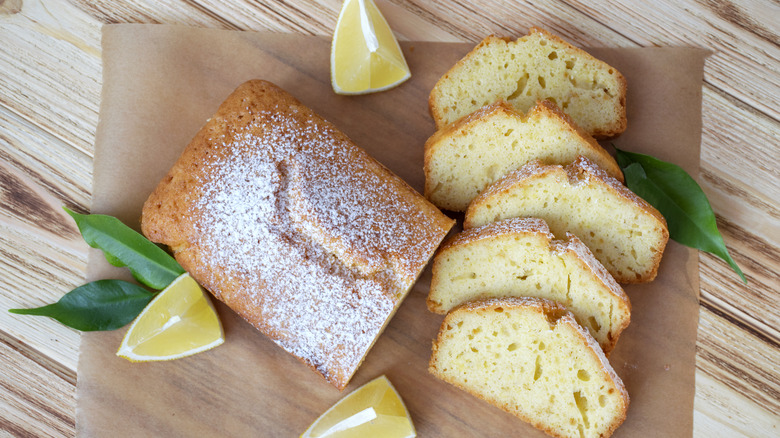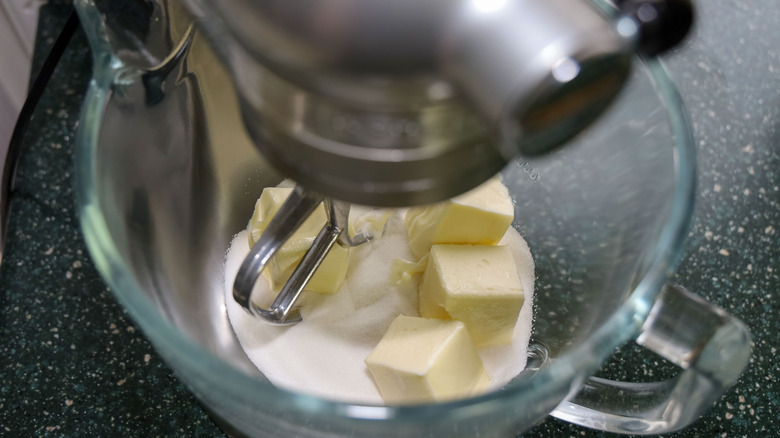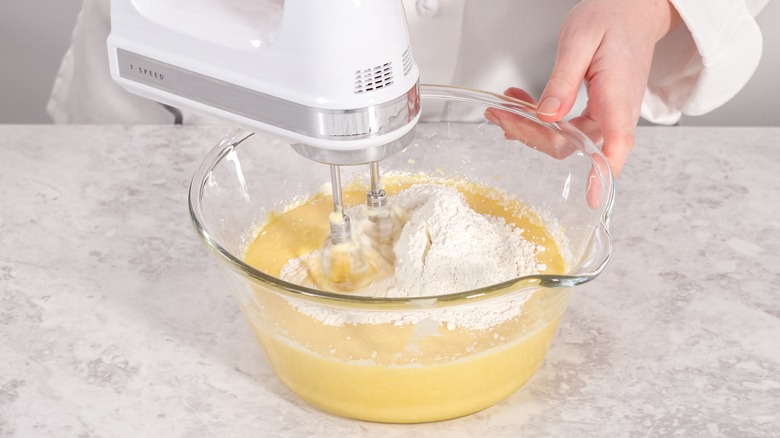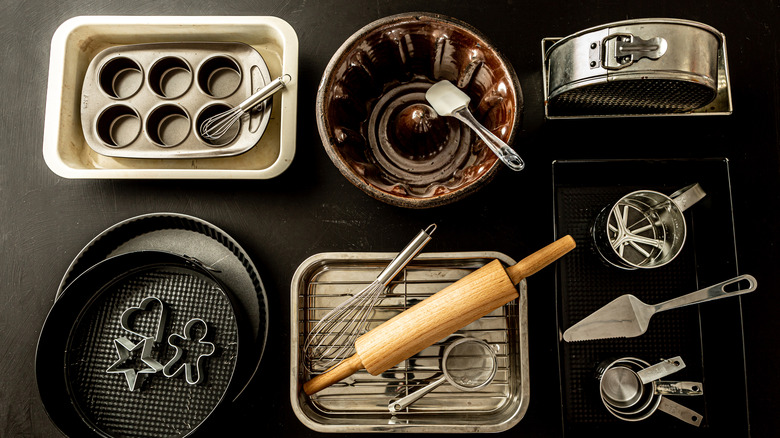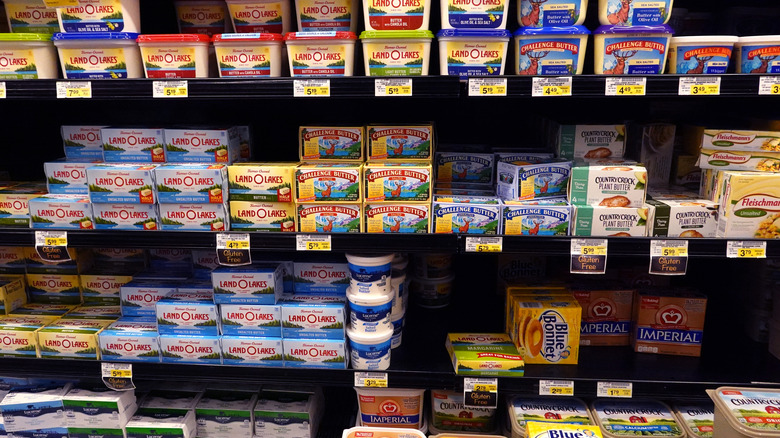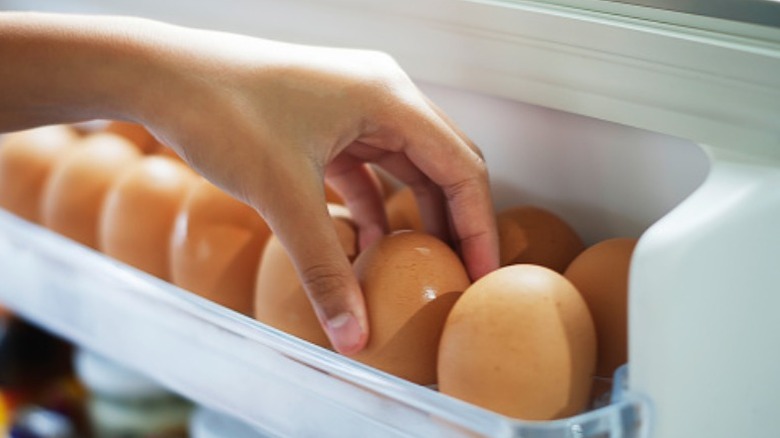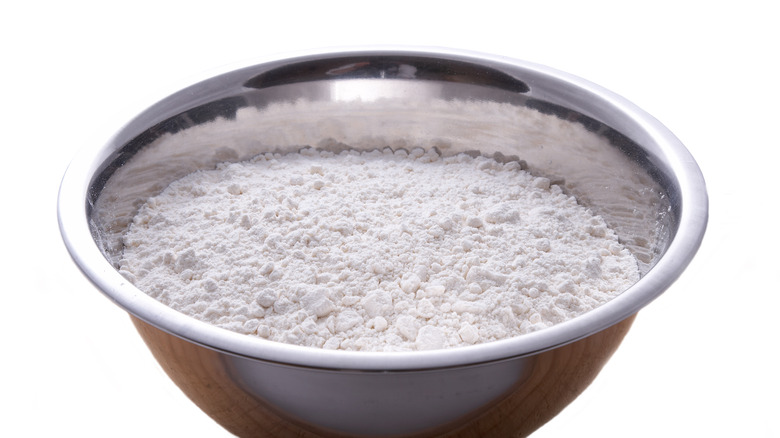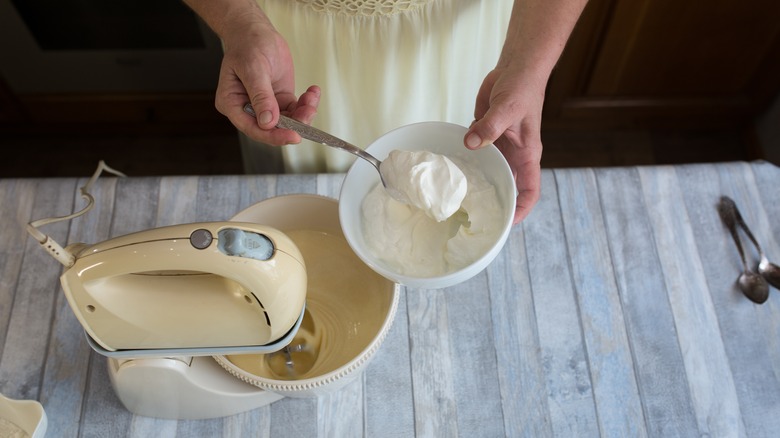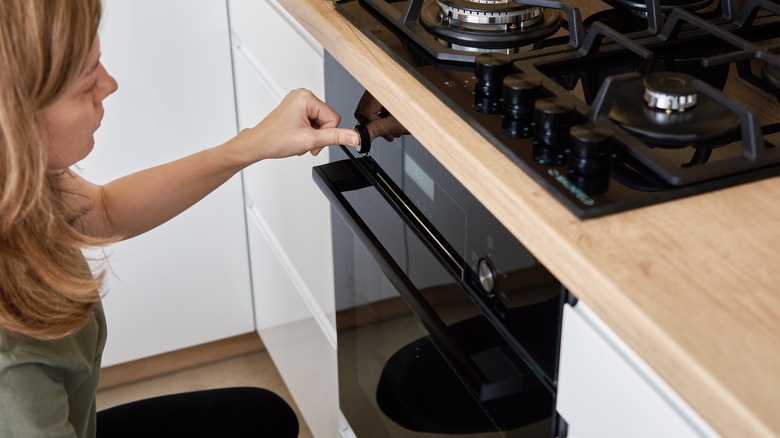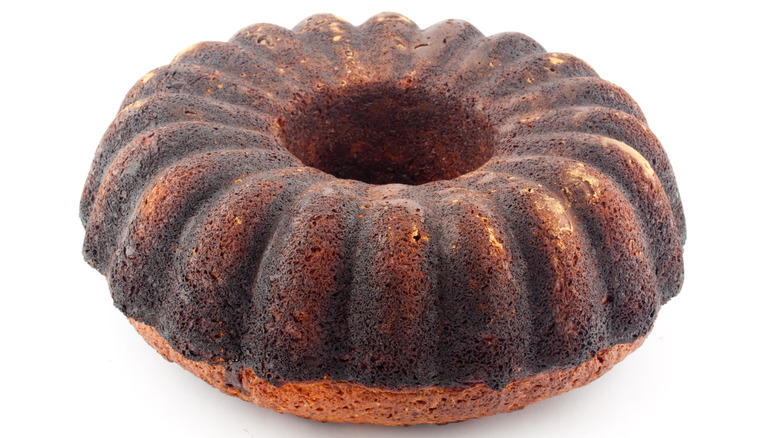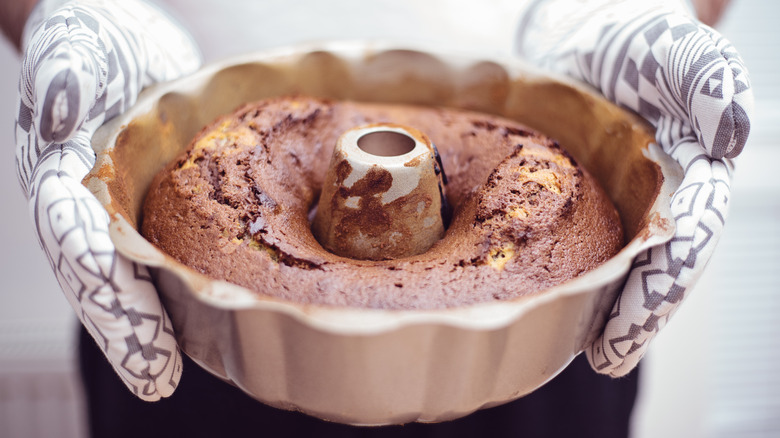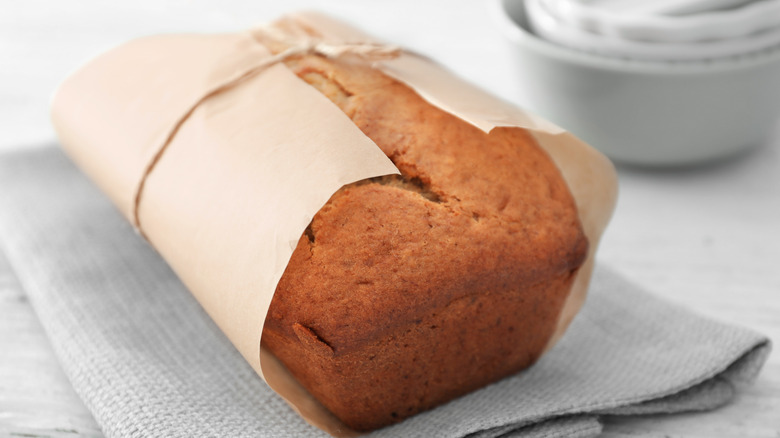12 Common Mistakes To Avoid When Making Pound Cake
In the world of baking, pound cake has one of the most straightforward formulas, so it's hard to mess it up, right? Not exactly; several bad baking habits can be detrimental to the dessert. Unfortunately, you might be guilty of them, even when you make the traditional recipe that requires only four ingredients. If you're not careful, the cake can lack flavor or have a funky look to it. And although pound cake is naturally a bit dense, you don't want it to reach the point where it becomes too solid to enjoy.
The order in which you add the ingredients, the equipment you use, and the amount of time you spend mixing the components all go into making the perfect pound cake. Luckily, once you know what to do and what to avoid, there is a noticeable difference in the taste, appearance, and consistency of the baked good. This applies if you make the classic version (which calls for a pound of butter, sugar, eggs, and flour) or alter the recipe to include more. One thing is sure: If you want your pound cake to come out of the oven with flying colors, you should refrain from making these errors.
1. Mismeasuring the ingredients
No matter what you bake, you should never carelessly measure ingredients; this is especially true for pound cake, though, which relies on exact measurements to turn out right. Specifically, using the wrong amount of flour is a simple measuring mistake you must stop making. Too much flour, and your loaf cake feels more like a brick than anything. On the other hand, it negatively affects the cake's structure if you under measure too. The greatest way to combat this is to use a utensil to fill the measuring cup rather than sticking the cup into the flour itself. Then, level it off, so there isn't a heap surpassing the cup's top.
Also, if you have a habit of approximating other ingredient amounts, it doesn't take much effort to fix this pattern. Stay away from novelty measuring cups if you want to perfect your bakes. You might not realize how much impact the cutesy teaspoons and cups have on your pound cake. Although they are fun, they are often not as accurate as they should be. Instead, stick to standard measuring cups or use a scale for precision. Even if your recipe has the ingredients listed in volume, there are online conversion charts that help you convert the volume to weight. You can find kitchen scales in stores like Target or Walmart, or online too.
2. Failing to cream the butter and sugar correctly
It is vital to execute the creaming method properly when you make a traditional pound cake. In particular, you shouldn't rush beating the butter. You see, when you whip the butter, it not only breaks it down, but it also incorporates air into it. As a result, the cloud-like butter prevents the cake from being tough. So, don't make the error of hurrying this procedure; slow and steady wins the race.
Add the butter first and smooth any large pieces before you throw in the sugar. You can count on it taking up to seven minutes for the mixture to reach the right consistency. Furthermore, don't forget to scrape the bowl when you blend the two components. Use a rubber spatula or another somewhat flexible tool and drag the ingredients down the side of the bowl to the bottom; this simple step ensures everything becomes evenly incorporated, and there are no lumps.
If you choose a tabletop mixer, it is best to use a paddle attachment. While a whisk still works, butter lumps will likely get stuck, and you might mix too much air into the butter. You can also use a handheld mixer or do it by hand if necessary. Stop mixing once it's light in color and has a spreadable consistency.
3. Overmixing the batter
For the best pound cake possible, don't overdo it when you mix the batter. Certain ingredients in the mixture are delicate and must be handled carefully, like eggs and flour. The reason why you shouldn't overbeat the eggs for pound cake is that it makes the cake crumbly. First, the overmixed eggs give you trouble because it makes a mess in your oven; the batter oozes out of the baking dish. Then, once you cut into the baked cake, the weakened structure doesn't hold up as it should. To prevent those things from happening, simply whisk the eggs separately to blend the whites and yolks. Then, add it to the butter and sugar in a few batches until combined.
On the other hand, there is another problem that happens if you overmix pound cake batter: The gluten tightens. What does this mean, exactly? There is gluten in the flour, and the more you work it, the more it becomes elastic. You certainly don't want this to happen to the dough because the cake's texture becomes unpleasant when it bakes. To avoid this, gently fold in the flour. You no longer need to mix it once it combines with other ingredients.
4. Utilizing the wrong kind of pan and not prepping it
Ideally, for this bake, you shouldn't use the typical round cake pan; it is best cooked in a loaf pan. However, sometimes you make a large batch and have too much batter for a single loaf. For instance, you need two loaf pans with a chocolate sour cream pound cake recipe. Don't worry, though; Bundt pans are also a suitable option if you don't have multiple loaf pans sitting around (or if you don't have time to do it in batches). You can't just use any type of batter in a Bundt pan, but luckily, pound cake dough fits the bill because of its consistency. The thick mixture makes for a cake that retains shape and fills the crevasses without breaking when you release it.
Additionally, don't make the mistake of not prepping the pan because it makes the cake challenging to unmold. The best way to grease a pan for pound cake is to oil it and then coat it in flour. After you apply butter or another oil to the mold, sprinkle in flour and move the pan around, so it catches different spots. Tap the sides to eliminate any excess powder. With some desserts, you can get away with using exclusively nonstick spray on the pan, but that isn't the case here. Pound cakes need that thin layer of flour to rise because if it's too greasy, it doesn't spring up.
5. Failing to use quality butter
Butter has always been one of the core ingredients in classic pound cakes, even when the recipe was much more straightforward. The rich and creamy qualities of butter give the cake its indulgent nature. Therefore, when you make this baked good, you should never settle for low-quality butter. Many butter alternatives are on the market; sometimes, you might not even realize the product you buy is not the real deal. Or maybe you opt for imitation butter and assume it doesn't make much difference (hint: it does).
Of course, recipes like vegan pound cakes use substitutes for butter. But if you aim for authenticity, and can get your hands on it, use European butter; it has a deep taste and the perfect amount of fat. Not only that, but it isn't pale in color, so it makes your cake a gorgeous yellow. If you can't find it at the grocery store, American butter works too. Ultimately, make sure to buy butter products that are made with cream and aren't chock-full of vegetable oil.
6. Using cold ingredients
One of the mistakes everyone makes with cake is that they use ingredients straight from the refrigerator. While this practice isn't detrimental for all baked goods, you should steer clear of doing so when you make pound cake. Firstly, butter is rock-hard when cold, which makes it troublesome to whip. If you take it directly from the cooler to the mixer, there's a chance that it breaks up into large lumps rather than to a smooth spread. Additionally, it puts wear and tear on your mixer since it is strenuous for the machine.
Yes, you can try to microwave the butter to soften it first, but if you turn your back for a moment, it turns into a puddle. The clear solution is to allow the butter to reach room temperature before you work with it. This method applies to other typically chilled ingredients, too, like eggs and milk. When you plan an hour ahead to let these ingredients rest on the counter, they respond much better to the mixing process. In fact, you'll find it's easier to fluff them up when they're not cold. The final texture of your cake benefits from that greatly.
7. Not sifting the dry ingredients
Consider yourself lucky if you've never bitten into an unmixed flour lump in a baked good. Believe it or not, this happens when you fail to sift the dry ingredients in a recipe. It is okay to have a few tiny lumps in the batter, but you can avoid them altogether if you use a sieve. Whether your recipe calls for only one dry ingredient or includes others like leavening agents, you'll want to run them all through the sifter. This tedious yet advantageous approach rids the mixture of unwanted chunks. Moreover, you incorporate a bit of air into it when you sift the flour.
Some formulas, like lost-and-found lemon pound cake, take advantage of this and require you to sift it multiple times. However, you shouldn't need to do it more than three times to achieve the perfect result. Also, don't neglect reading the recipe when it comes to sifting. Some recipes call for already sifted flour, which means you measure the ingredient after you sift it. However, most of the time, you can measure the amount beforehand. In the end, even if the recipe doesn't mention to sift the flour, it doesn't hurt to be safe and create a silky-smooth batter for your pound cake.
8. Skipping out on other ingredients for moisture
Although classic pound cakes have very few ingredients, it is beneficial to include additions in some instances. After all, many baked goods evolve, so if you tweak it just a bit to make it better, it doesn't make the pound cake worth any less. For example, if your bakes repeatedly turn out dry, sour cream can be the ingredient that forever changes your classic pound cake. This ingredient counteracts the lack of moisture in the recipe, which creates a pleasantly soft dessert. In addition, depending on how much you choose to add, it also has the ability to add a tart undertone to the cake.
Sour cream isn't the only lifesaver; use yogurt to create a tender sweet treat. For example, lemon yogurt pound cake calls for 6 ounces of lemon-flavored yogurt; this adds citrus notes to the dessert and prevents dryness. If you desire to stick with the traditional ingredients in the crumb, make a simple syrup and soak the cake after it's baked. Simmer equal parts water and sugar on the stovetop, then use a brush or squeeze bottle to hydrate the cake with the liquid. You'll never make a brittle pound cake again.
9. Baking it at the wrong temperature
Some folks might think it's harmless to crank the oven a little higher than their recipe calls for. Yet, if you take this route, you play with fire because the outside of the cake becomes dark while the inside is still a gooey mess; this is why it's so critical to bake pound cakes between a specific temperature range. Our tip to help you bake your best cake yet is to have your oven set to 325 degrees Fahrenheit. Meanwhile, to make moist loaf-shaped cakes, raise the oven to 350 degrees Fahrenheit.
On top of that, you're likely making another oven mistake with pound cake and didn't even realize it. The mistake? When you preheat the baking appliance. Yep, that's right, for a fluffier pound cake every time, don't preheat your oven. Instead, place the baking dish in it while it's cold. Then, turn on the heat and allow the batter to come up to temperature with the heating element. When the ingredients gradually warm up, any leavening agents involved have plenty of time to work their magic and create a pillowy crumb.
10. Under or overbaking it
Making an underbaked cake (or a burnt one) has likely happened to all of us at some point. It's a mistake that can cost you your whole dessert, so you should know when to remove the baked good from the oven. Even if the recipe suggests the cake should be ready after a certain time, check it with a toothpick to verify it is. Insert it into the tallest part of the cake — you're good to go if no mushy batter comes up with the toothpick.
You can also use a finger to apply light pressure on the top of the cake. Observe if it creates a divot in the crust or pops right back up. If the cake top sinks where you touched it, you need to give it longer in the oven.
Alternatively, you might end up with a super dark cake if you are overcautious about underbaking it or forget it was in the oven. As a result, its texture suffers, and it might even shrivel into a sad-looking loaf. To prevent this, remember to set timers and cover the cake if you feel the surface is becoming too dark too soon.
11. Removing it from the pan too soon
If you've baked an impressive pound cake, the last thing you want to do is unmold it prematurely. It's undoubtedly tough to be patient when it comes to sweet treats, and you might want to slice right into it as soon as it comes out of the oven. However, it is a considerable risk because you might accidentally break the cake.
Even if you don't have trouble when you initially take the hot cake out of the baking dish, it is highly fragile. Try slicing into it before it cools and it crumbles, losing its shape that you worked so hard to create. It's wise to know when to remove a cake from the pan to avoid mishaps. Generally, wait at least 20 minutes or longer for the pound cake to rest. Not only does this ensure your cake comes out in one piece, but it makes the whole process smoother because the cake's sides pull away from the pan.
12. Improperly storing it
Whatever you do, don't carelessly store the scrumptious cake because it shortens its shelf life significantly. As it is, pound cake only lasts two to seven days (unless you freeze it, of course). So, if you store it unwrapped, you'll be able to enjoy it for even less time than that. Tightly swaddle the baked good in plastic wrap to keep it as fresh as possible. It is safe to store the covered cake on the countertop, but you can keep it in the fridge too.
The good news is that the refrigerator keeps bacteria levels at bay, according to the U.S. Department of Agriculture. So, when the cake is in a chilled environment, it stays edible for longer. The only downside is the cooler tends to rid the cake of much-needed moisture. However, an easy way to ensure already-cut cake doesn't dry out is to use parchment paper. Place a piece of parchment against the exposed side of the cake for an extra layer of protection before you enclose it in food wrap.
